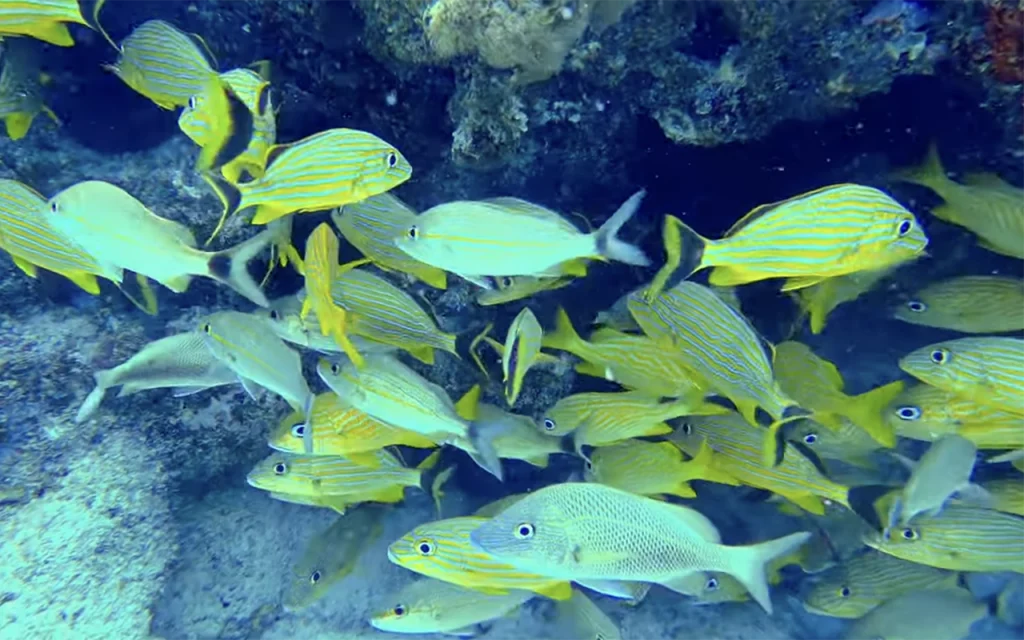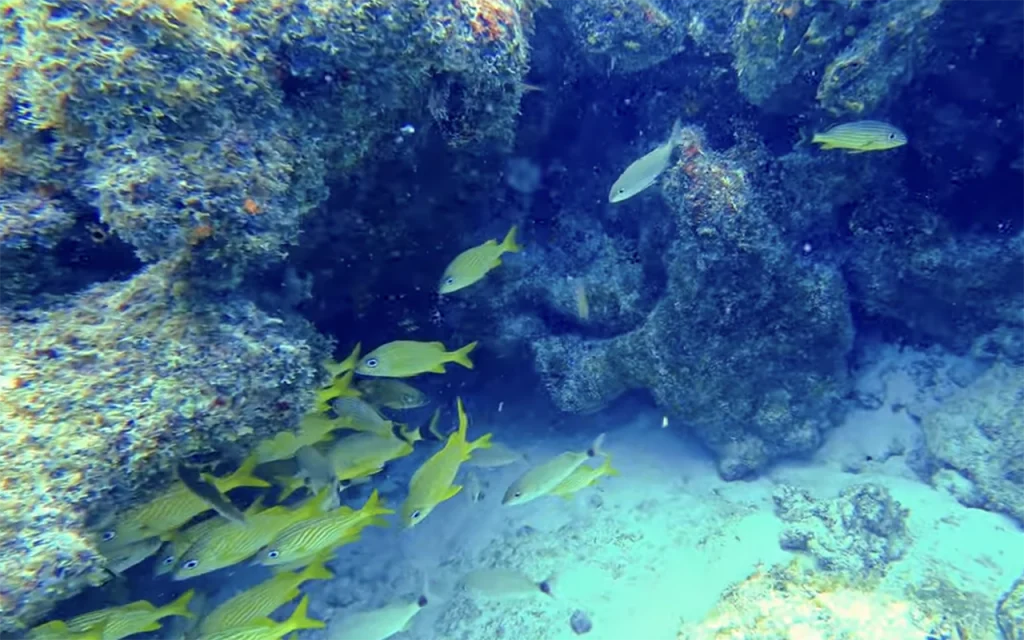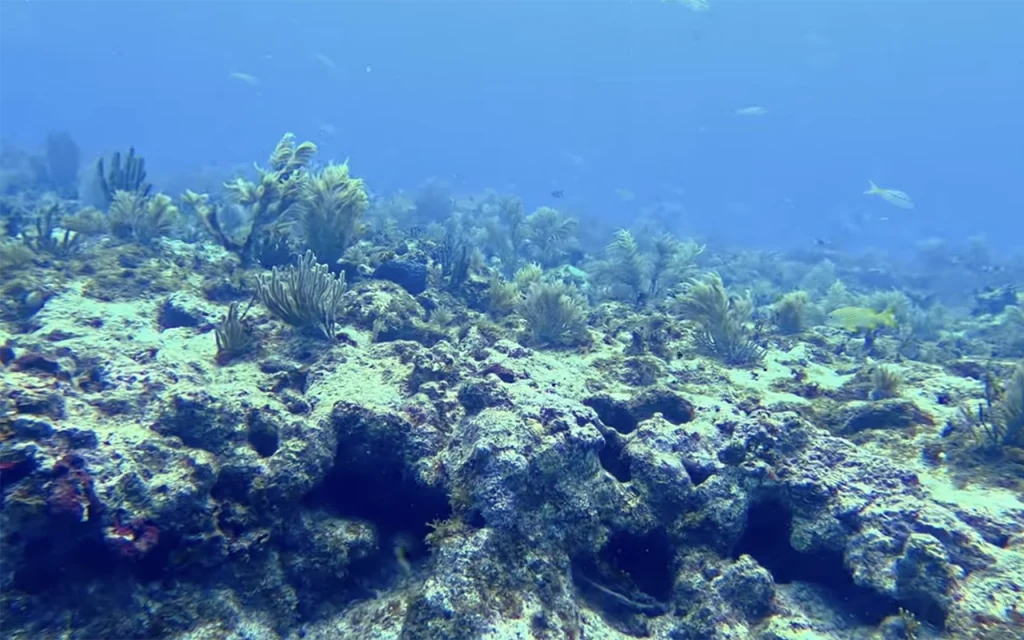Table of Contents

Davis Reef is well-regarded among divers for its accessibility, rich marine life, and beautiful underwater scenery, making it a must-visit location in the Florida Keys.
Article at a Glance
- Location: Situated in Islamorada, Florida Keys, Davis Reef is a popular diving destination known for its vibrant marine life and stunning coral formations.
- Depth Range: The reef features shallow depths of 15 to 30 feet, making it ideal for beginners, while deeper sections can reach up to 80 feet for advanced divers.
- Visibility: Divers can typically enjoy excellent visibility, often exceeding 50 feet, which enhances the underwater experience and photography opportunities.
- Marine Life: Expect to encounter a diverse array of marine species, including green moray eels, nurse sharks, and colorful tropical fish, contributing to an engaging dive.
- Unique Features: The reef is home to the iconic Buddha statue, a popular photo spot, along with well-developed coral formations that create a picturesque underwater landscape.
- Best Time to Dive: Optimal diving conditions are generally found from April to Juneand September to November, avoiding the peak hurricane season.
- Suitability: Davis Reef caters to both novice and experienced divers, offering guided dives and snorkeling opportunities for those looking to explore its underwater beauty.
Davis Reef Islamorada
Dive Site Characteristics
- Depth: 15-30 feet
- Site Type: Reef
- Special Features: Sanctuary Preservation Area
Marine Life and Ecosystem
Davis Reef is home to a rich and diverse marine ecosystem. Divers can expect to encounter:
- Large green moray eels
- Nurse sharks
- Stingrays
- Abundant gorgonian species, including:
- Sea rods
- Sea whips
- Sea feathers
- Sea fans
Unique Attraction
The reef features a notable Buddha statue located next to a large brain coral, adding an intriguing element to the dive experience4.Diving Suitability
- Excellent for both new divers and snorkelers
- Shallow depth makes it accessible to a wide range of skill levels
- Ideal for underwater photography and marine life observation
What Marine Life Can I Expect To See?
Marine Life at Davis Reef
- Tropical Fish: Expect to encounter large schools of fish, including:
- French Grunts
- Goatfish
- Queen Angelfish
- Eels: The reef is known for its population of green moray eels, which can often be seen swimming freely among the coral formations.
- Sharks: Look out for nurse sharks lurking beneath overhangs, and occasionally, you might spot other species such as bull sharks or reef sharks.
- Stingrays: These graceful creatures can be seen gliding along the sandy bottom.
- Sea Turtles: Both loggerhead and green sea turtles are common sights, adding to the allure of the dive.
- Coral and Gorgonians: Davis Reef features a variety of soft corals, including:
- Sea rods
- Sea whips
- Sea fans
These corals provide habitat and shelter for many marine species.
- Unique Attractions: A notable feature of the reef is a Buddha statue, which divers often visit, alongside large brain corals that create a picturesque setting.
Diving Conditions
- Depth: The reef’s depth ranges from 15 to 30 feet, making it accessible for both novice and experienced divers.
- Visibility: Generally good visibility allows for excellent underwater photography opportunities.

What Do Divers Say About This Site?
Positive Aspects
- Accessibility: Many divers appreciate the shallow depths (10 to 30 feet), making it an ideal spot for both beginners and experienced divers. This accessibility allows for easy navigation and enjoyable dives without the need for extensive training.
- Marine Life: Divers frequently mention the abundance of marine life, including moray eels, turtles, and vibrant schools of tropical fish. The presence of unique features like the Buddha statue adds to the site’s charm and intrigue, making it a favorite for underwater photography.
- Visibility: The clear waters at Davis Reef contribute to a pleasant diving experience, allowing divers to fully enjoy the colorful coral formations and diverse marine species.
Recommendations
- Snorkeling Opportunities: In addition to scuba diving, Davis Reef is also popular among snorkelers. This dual appeal makes it a versatile destination for various water activities.
- Diving Conditions: Divers note that conditions are generally favorable, with warm waters and good visibility, enhancing the overall experience. Many recommend visiting during off-peak times to avoid crowded dive boats.
Key Information
| Feature | Details |
|---|---|
| Location | Islamorada, Florida Keys |
| Depth Range | 15 to 30 feet (4.5 to 9 meters) |
| Advanced Depths | Up to 80 feet (24 meters) in certain sections |
| Visibility | Typically exceeds 50 feet |
| Marine Life | Green moray eels, nurse sharks, tropical fish |
| Unique Features | Buddha statue, vibrant coral formations |
| Diving Suitability | Suitable for beginners and advanced divers |
| Best Time to Dive | April to June and September to November |
| Water Temperature | Mid-70s to mid-80s °F (21-29 °C) |
| Snorkeling Opportunities | Yes, accessible for non-divers |
| Conservation Status | Sanctuary Preservation Area |
Highlights of Diving This Site?
- Abundant Marine Life: Divers frequently note the rich biodiversity at Davis Reef, including large populations of green moray eels, nurse sharks, and various tropical fish species. The presence of these creatures provides an exciting and dynamic diving experience.
- Shallow Depths: The reef’s depth ranges from 10 to 30 feet, making it accessible for beginners while still enjoyable for seasoned divers. This shallow environment allows for longer dive times and easier navigation.
- Unique Features: One of the standout attractions is the Buddha statue, which is often highlighted in dive logs and adds an intriguing element to underwater exploration. Divers enjoy capturing photographs of this unique landmark amidst the coral formations.
- Good Visibility: Many divers report favorable visibility conditions, which enhance the experience by allowing for clear views of the vibrant coral reefs and marine life. This aspect is particularly beneficial for underwater photography.
- Snorkeling Opportunities: In addition to scuba diving, Davis Reef is also a favored spot for snorkelers, making it a versatile location for various water activities. The shallow waters are ideal for those looking to explore without diving gear.
- Safety and Comfort: The relatively calm waters and manageable conditions contribute to a safe diving environment, which is especially appealing for less experienced divers. Many divers feel comfortable exploring this site due to its welcoming atmosphere.
My Favorite Dive Computers
I have compared the 3 top diving computers for each category to help making the right choice easier:
Iconic Spots At This Site
- Buddha Statue: One of the most famous features of Davis Reef is the Buddha statue, often referred to as “Buddha’s Belly.” Divers enjoy rubbing the statue for luck, and it has a storied history of being lost and recovered. This unique landmark is nestled among vibrant coral formations, making it a popular photo opportunity.
- Coral Formations: The reef is home to a variety of well-developed gorgonians, including sea rods, sea whips, sea feathers, and sea fans. These soft corals create a stunning underwater landscape that attracts a wide array of marine life.
- Marine Life Hotspots: Divers can expect to see large populations of green moray eels, nurse sharks, and various species of tropical fish. The abundance of marine life makes every dive an exciting adventure.
- Navigable Ledge: The reef forms an easily navigable ledge that encourages divers to explore in one direction and then return along the top. This layout allows for a comprehensive view of both the reef’s surface and its underwater features.
- Sanctuary Preservation Area: As part of the Davis Reef Sanctuary Preservation Area, this site benefits from protective regulations that help maintain its biodiversity. This status ensures that fish and crustacean populations thrive, enhancing the overall diving experience.
Environmental Conservation Efforts at Davis Reef
Florida Reef Resilience Program (FRRP)
The FRRP plays a crucial role in protecting and managing Davis Reef along with other parts of Florida’s Coral Reef. Key aspects of this program include:
- Monitoring reef health and status
- Identifying factors that contribute to reef resilience
- Informing efforts to reduce negative impacts and stressors on reefs
The program brings together various partners, including The Nature Conservancy, government agencies, and academic institutions, to address issues that cross jurisdictional boundaries1.
Sanctuary Preservation Area Status
Davis Reef is designated as a Sanctuary Preservation Area (SPA) within the Florida Keys National Marine Sanctuary. This designation provides several protective measures:
- Prohibition of fishing and harvesting activities
- Restrictions on discharging matter except cooling water or engine exhaust
- Ban on touching or standing on living or dead coral
- Prohibition of anchoring on coral or when mooring buoys are available
Coral Restoration Efforts
In response to recent coral bleaching events and ongoing threats to reef health, there are increased efforts for coral restoration in the Florida Keys:
- The Nature Conservancy is working with reef managers to develop a restoration strategy for the state
- Focus on identifying priority areas where outplanted corals are most likely to contribute to the system’s recovery
- Development of detailed restoration plans for specific areas, including the Kristin Jacobs Coral Reef Ecosystem Conservation Area4
Water Quality Improvements
Efforts are being made to improve water quality in the sanctuary, which is essential for maintaining biodiversity. For example, there are proposals to prohibit cruise ships from discharging greywater and deck washdown within the sanctuary.

Maximizing Your Diving Experience at Davis Reef
Planning Your Dive
- Best Time to Visit: While Davis Reef is diveable year-round, the summer months typically offer warmer water temperatures and better visibility. However, be aware of the hurricane season from mid-August to late September.
- Dive Operators: Choose a reputable dive operator in Islamorada. The Florida Keys Dive Center, located nearby, offers trips to Davis Reef and other popular sites in the area.
Diving Tips
- Depth and Experience: With depths ranging from 15 to 30 feet, Davis Reef is suitable for divers of all levels. Take advantage of the shallow depths to enjoy longer bottom times.
- Navigation: The reef forms an easily navigable ledge. Consider exploring in one direction and returning along the top for a comprehensive view of both the reef’s surface and underwater features.
- Photography: Bring an underwater camera to capture the vibrant marine life and the iconic Buddha statue. The good visibility and shallow depths make for excellent photo opportunities.
Highlights to Look For
- Buddha Statue: Don’t miss the famous Buddha statue, a unique feature of this reef. It’s a popular spot for photos and considered lucky by some divers.
- Marine Life: Keep an eye out for green moray eels, nurse sharks, and various tropical fish species. The reef’s status as a Sanctuary Preservation Area ensures abundant marine life.
- Coral Formations: Observe the well-developed gorgonians, including sea rods, sea whips, and sea fans, which create a stunning underwater landscape.
Conservation Awareness
- Responsible Diving: Practice good buoyancy control to avoid damaging the delicate coral structures. Remember that touching or standing on living or dead coral is prohibited.
- Marine Protected Area: Be aware that Davis Reef is part of a Sanctuary Preservation Area. Familiarize yourself with the regulations, which include no fishing or harvesting.
Capturing Memories at Davis Reef Valley: Photography Tips
Equipment Preparation
- Underwater Housing: Ensure your camera is equipped with a reliable underwater housing to protect it from water damage and allow for clear shots.
- Macro Lens: Consider using a macro lens for close-up shots of coral and marine life. This will help you capture intricate details that are often missed with standard lenses.
- Tripod or Stabilization: Although using a tripod underwater can be challenging, stabilizing your camera as much as possible will help reduce shake, especially for macro shots.
Camera Settings
- Shoot in RAW: If your camera allows, shoot in RAW format to give yourself more flexibility in post-processing, especially for correcting white balance and exposure issues.
- White Balance: Set your white balance manually to match the lighting conditions. Underwater environments can distort colors, so adjusting this setting helps achieve more accurate color representation.
- Aperture Priority Mode: Use aperture priority mode to control depth of field. A wider aperture (lower f-stop number) allows more light in and creates a beautiful background blur, making your subject stand out.
Composition Techniques
- Angle of Shooting: Position your lens perpendicular to the subject to minimize distortion caused by water and glass. This technique is crucial when shooting through the surface of the water.
- Background Consideration: Ensure that the background complements your subject. Avoid cluttered backgrounds that can distract from the main focus of your shot.
Lighting Considerations
- Natural Light: Utilize natural light as much as possible. The best time for underwater photography is often mid-morning when sunlight penetrates deeper into the water.
- Avoid On-Camera Flash: Using on-camera flash can create harsh reflections and glare. Instead, consider using external strobes positioned strategically to illuminate your subjects without causing reflections.
Practical Tips
- Reduce Water Movement: If possible, turn off any currents or pumps in the area before taking photos to keep corals and marine life still for clearer shots.
- Practice Patience: Underwater photography often requires patience. Take your time to observe marine life and wait for the right moment to capture unique behaviors or interactions.
Frequently Asked Questions
When is the best time to dive Davis Reef?
The best time to dive at Davis Reef in Islamorada is generally considered to be during the spring and fall months, specifically from April to June and September to November.
Seasonal Considerations
Spring (April to June): This period typically offers warm water temperatures ranging from the mid-70s to mid-80s °F (approximately 24-29 °C) and good visibility. The weather is generally stable, making it an excellent time for diving.
Fall (September to November): After the summer heat, fall also provides favorable conditions. Water temperatures remain warm, and visibility is often good. However, be cautious of hurricane season, which peaks in August and September.
Winter (December to March): Winter months can bring cooler water temperatures, dropping into the mid-70s °F (around 21-24 °C). While diving is still possible, divers may experience choppier seas and lower visibility due to storms.
Summer (July to August):Summer months can be quite warm and humid above water, with water temperatures reaching the high 80s °F (around 30 °C). However, this season also poses a higher risk of thunderstorms and hurricanes, particularly in late summer.
Additional Tips
Dive Time: Regardless of the season, the best time of day for diving is often between 10 AM and 2 PM, when sunlight penetrates deeper into the water, enhancing visibility and illuminating the vibrant colors of the reef.
What is the visibility like while diving Davis Reef?
Typical Visibility ConditionsVisibility often exceeds 50 feet most of the time. The shallow depth (15-30 feet) contributes to excellent light penetration and clarity
Factors Contributing to Good Visibility
Shallow Depth: At depths between 15-30 feet, more sunlight penetrates the water
Water Conditions: The Florida Keys generally offer clear water environments
Reef Preservation: As a Sanctuary Preservation Area, the reef’s health contributes to better underwater visibility
Light Penetration Characteristics
In just 3-4 feet of water, about 45% of light energy is absorbed
At 35 feet, approximately 84% of available light energy is absorbed
Diving Experience
The excellent visibility makes Davis Reef perfect for:
Underwater photography
Marine life observation
Exploring coral formations
How deep are the dives at Davis Reef?
Diving at Davis Reef typically occurs at depths ranging from 15 to 30 feet (approximately 4.5 to 9 meters). This shallow depth makes it an ideal location for divers of all experience levels, allowing for longer bottom times and easier navigation.
The reef’s structure encourages exploration along its ledges, enhancing the overall diving experience while providing opportunities to observe diverse marine life and beautiful coral formations.
Is Davis Reef suitable for beginners?
Yes, Davis Reef is highly suitable for beginners.
Shallow Depths
Depth Range: The dives at Davis Reef typically range from 10 to 30 feet. This shallow depth is ideal for beginners, allowing for longer dive times and easier navigation without the complexities that come with deeper dives.
Abundant Marine Life
Rich Ecosystem: Beginners can enjoy observing a variety of marine life, including large green moray eels, nurse sharks, and colorful tropical fish. The presence of these species provides an engaging experience for new divers.
Easy Navigation
User-Friendly Layout: The reef’s structure is easily navigable, making it simple for beginners to explore without getting lost. This aspect contributes to a more relaxed diving experience.
Snorkeling Opportunities
Accessible for Non-Divers: In addition to scuba diving, Davis Reef is also popular among snorkelers. This allows those who may not be certified divers to still experience the underwater beauty of the reef.
Supportive Environment
Diving Schools and Guides: Many dive operators in the area offer introductory courses and guided dives specifically designed for beginners. This support helps new divers feel more comfortable and confident underwater.
Is Davis Reef suitable for advanced divers?
Diving Levels at Davis Reef
Beginner-Friendly Areas
Shallow Depths: Most of the reef ranges from 15-30 feet, making it ideal for novice divers
Easy Navigation: The reef structure allows for simple exploration
Rich Marine Life: Abundant tropical fish and marine creatures make it engaging for new divers
Advanced Diving Sections
Davis Ledge: A section that can reach depths up to 80 feet, specifically suited for advanced divers
Two Mooring Balls: Located in the deeper section of the reef
Complex Underwater Terrain: Offers more challenging diving experiences for experienced divers
Dive Characteristics
Varied Depth Ranges:Shallow areas: 15-30 feet (beginner-friendly)
Deeper sections: Up to 80 feet (advanced divers)
Marine Life: Large green moray eels, nurse sharks, and diverse tropical fish populations





